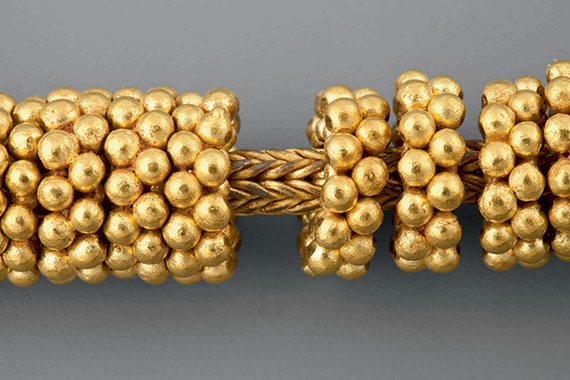 |
| Detail of a neck ornament. Ayala Museum, 81.5171. Photography by Neal Oshima; Image courtesy of Ayala Museum |
This is what made the Srivijayan-Majapahit Empire the richest empire during those times:
"It was no surprise why the Majapahit Empire was the richest kingdom in the world when it had controlled the Maharlikan archipelago. The same reason is also attributed to the legendary King Solomon’s temple made of gold that were mined from the land of Ophir." (The Maharlikans: Fact #8)
The polity known as Butuan in the southern Philippines rose to commercial prominence in the tenth century, but ultimately declined in the thirteenth century for unknown reasons. The cultural area associated with this land transcended the political boundaries of the present-day Philippine provinces of Agusan del Norte, Agusan del Sur, and Surigao del Sur.
Early Chinese sources offer clues to the power of Butuan at its peak. The Song Shi (History of the Song) documents that the Butuan king Ch’i-ling, or Kiling, sent emissaries to the Chinese imperial court in 1003 and 1007 and other texts make note of trade between China and Butuan. The astonishing quantities and impressive quality of gold treasures recovered in Butuan suggest that its flourishing port settlement played an until recently little-recognized role in early Southeast Asian trade. Surprisingly, the amount of gold discovered in Butuan far exceeds that found in Sumatra, where the much better known flourishing kingdom of Srivijaya is said to have been located.
Highlighted in this section of the exhibition are selections from a spectacular hoard of gold necklaces, chains, waistbands, bangles, ritual bowls, implements, and ceremonial weapons that was accidentally discovered in 1981 in the hamlet of Magroyong near Butuan. Objects from this cache, known as the Surigao Treasure, are among the most intriguing in the collection of early Philippine gold objects assembled from the 1960s to 1981 by archaeologist-collector Cecilia Y. Locsin (1930–2013) and her husband Leandro V. Locsin (1928–1994) that are now part of the collections of the Ayala Museum.
The personal adornments recovered from Butuan appear to be primarily elite regalia. These splendid adornments and ritual objects were probably part of a ruling family’s bahandi, or collective heirloom wealth. The identity and fate of the royal family who presumably owned the treasures are unknown. Future excavations in Butuan may provide us with more information about everyday life in the ancient society that produced these technically astounding works.
Source: The Kingdom of Butuan
Early Chinese sources offer clues to the power of Butuan at its peak. The Song Shi (History of the Song) documents that the Butuan king Ch’i-ling, or Kiling, sent emissaries to the Chinese imperial court in 1003 and 1007 and other texts make note of trade between China and Butuan. The astonishing quantities and impressive quality of gold treasures recovered in Butuan suggest that its flourishing port settlement played an until recently little-recognized role in early Southeast Asian trade. Surprisingly, the amount of gold discovered in Butuan far exceeds that found in Sumatra, where the much better known flourishing kingdom of Srivijaya is said to have been located.
Highlighted in this section of the exhibition are selections from a spectacular hoard of gold necklaces, chains, waistbands, bangles, ritual bowls, implements, and ceremonial weapons that was accidentally discovered in 1981 in the hamlet of Magroyong near Butuan. Objects from this cache, known as the Surigao Treasure, are among the most intriguing in the collection of early Philippine gold objects assembled from the 1960s to 1981 by archaeologist-collector Cecilia Y. Locsin (1930–2013) and her husband Leandro V. Locsin (1928–1994) that are now part of the collections of the Ayala Museum.
The personal adornments recovered from Butuan appear to be primarily elite regalia. These splendid adornments and ritual objects were probably part of a ruling family’s bahandi, or collective heirloom wealth. The identity and fate of the royal family who presumably owned the treasures are unknown. Future excavations in Butuan may provide us with more information about everyday life in the ancient society that produced these technically astounding works.
Source: The Kingdom of Butuan




